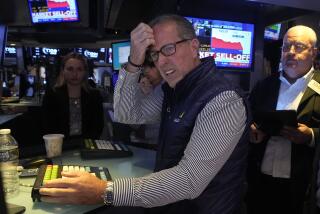Brazil’s Problems Pose Big Risks to U.S., Other Nations
- Share via
WASHINGTON — Like an old injury that flares anew, the financial spasm that rattled Brazil and the financial world Wednesday showed--in unnerving fashion--how the global economy remains threatened by problems that only recently seemed to have faded away.
Brazil’s financial fragility poses considerable risks for the United States, analysts said Wednesday, both through the vast economic relationship between the United States and Latin America and from the possibility that the new crisis would take a toll on the American stock market and its consumers. Early Wednesday, the Dow Jones industrial average plunged more than 261 points before achieving a partial recovery.
“You’ve got a reminder that the world around us is still seizing up,” said James E. Glassman, senior U.S. economist at Chase Securities in New York. “There still are strains out there, and you’re not going to be out of the woods until the global economy starts to grow again.”
Even more broadly, Brazil’s abrupt devaluation of its currency Wednesday underscores how much the financial turmoil that began in Thailand in 1997 has achieved a beachhead in the Western Hemisphere, threatens the Mexican peso and represents an unwelcome new challenge to U.S. economic growth, which was already expected to slow this year.
Further, the new crisis raises more questions about officials’ ability to combat the financial gyrations that have threatened entire economies and bulldozed across national boundaries over the last 18 months.
In November, Brazil was granted a $41.5-billion international aid package engineered by the International Monetary Fund and the U.S. Treasury. Wednesday’s developments raised doubts as to whether the strategy would work, or even whether the smartest economic minds in the world could master the dizzying financial problems that continue to erupt in varied countries.
“It’s like a computer virus running through software,” said Allen Sinai, chief economist at Primark Decision Economics in Boston. “It’s not over. No one can know when it ends.”
As financial debacles in East Asia and Russia have emerged as major concerns since mid-1997, U.S. officials have sought to draw a firm line protecting Brazil, which has teetered since last summer as the potential next domino in the grim collapse of emerging economies.
Severe downturns throughout Asia already have taken a big toll on U.S. manufacturers and exporters, yet the nation’s economy has so far weathered the storm. U.S. officials have sought to prevent a Latin American imbroglio that would severely worsen the threat.
The rescue plan for Brazil, which included $5 billion from the United States, was intended to restore investor confidence in the South American giant, which for some time has been criticized for running a bulky budget deficit and attempting to prop up its currency to an unrealistically high value. Brazil also was given faster access to the money than in other aid packages, all part of a strategy to ameliorate jittery creditors’ concerns.
Increasingly, however, signs that Brazilian legislators were resisting new conditions of economic austerity have eroded investor confidence and unleashed fierce downward pressure on its currency.
After a joint appearance Wednesday with President Clinton in an effort to calm market turmoil, U.S. Treasury Secretary Robert E. Rubin said he was in close touch with authorities in Brazil, other key economies and the IMF. “It is important that Brazil carry forward the implementation of a strong, credible economic program,” he said in a statement.
While economists said it was too soon to know where Brazil’s travails would lead the global economy, they agreed that the most acute risk focuses on its neighbors in Latin America, with potentially negative fallout for the United States.
Brazil is a critical market for U.S. exports--the 11th-largest--and one of the few major trading partners with which this country maintains a trade surplus. Furthermore, the United States sends some 20% of its exports to Latin America, much of which could be led into recession by Brazil in the coming months.
Mexico may suffer not only through reduced business with Brazil, but also through reduced business with the United States if broadening weakness in South America takes a bite out of U.S. economic growth in 1999.
In addition to the “real world” effects that a sharp Brazilian downturn would exert on trade, a currency crisis there could reverberate in uncertain psychological ways.
Wednesday’s Dow activity notwithstanding, some observers worry that given the recent run-up of prices on Wall Street, any shock such as Brazil’s devaluation has the potential to push stocks downward.
“I wouldn’t be surprised to see the stock market go down considerably more within the next few days,” said Nariman Behravesh, chief international economist at Standard & Poor’s DRI in Lexington, Mass..
Given the many uncertainties, analysts were cautious Wednesday about predicting the full implications of financial chaos in Brazil.
Some economists now believe that Asia’s situation has started to improve, with economic growth expected in South Korea and some other countries, although Japan remains a huge question mark not only for Asia but for the global economy.
Also, the raw and enduring power of the U.S. economic expansion has surprised many who had expected last year’s global woes to cripple the economy.
Be that as it may, Glassman of Chase Securities said it is too soon to say the U.S. will escape relatively unscathed.
“Even though the U.S. economy has weathered the crisis so far, it’s too early to claim that this is not going to be a major event,” he said. “It could erupt into something worse.”
Times staff writer Chris Kraul in San Diego contributed to this report.
More to Read
Sign up for Essential California
The most important California stories and recommendations in your inbox every morning.
You may occasionally receive promotional content from the Los Angeles Times.









